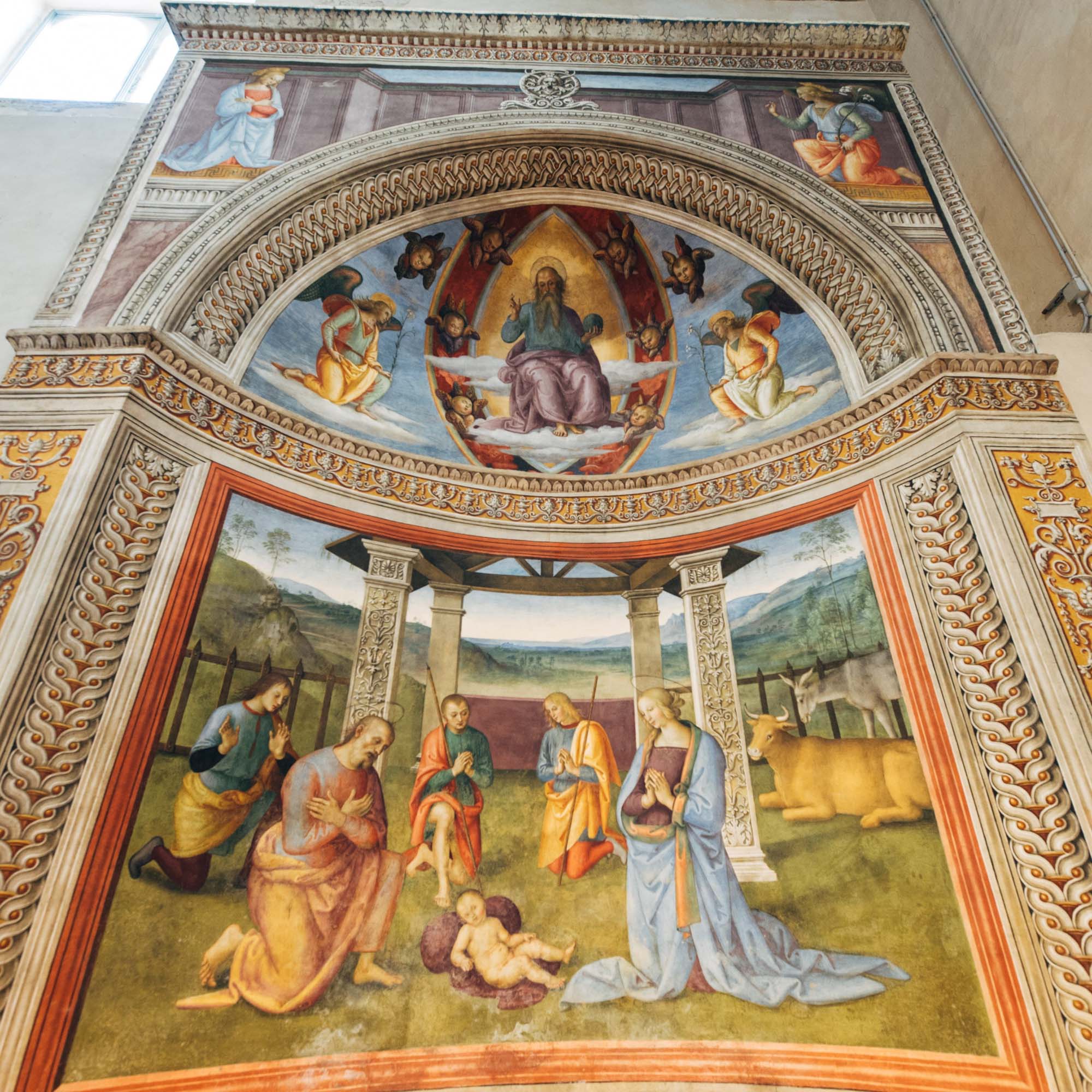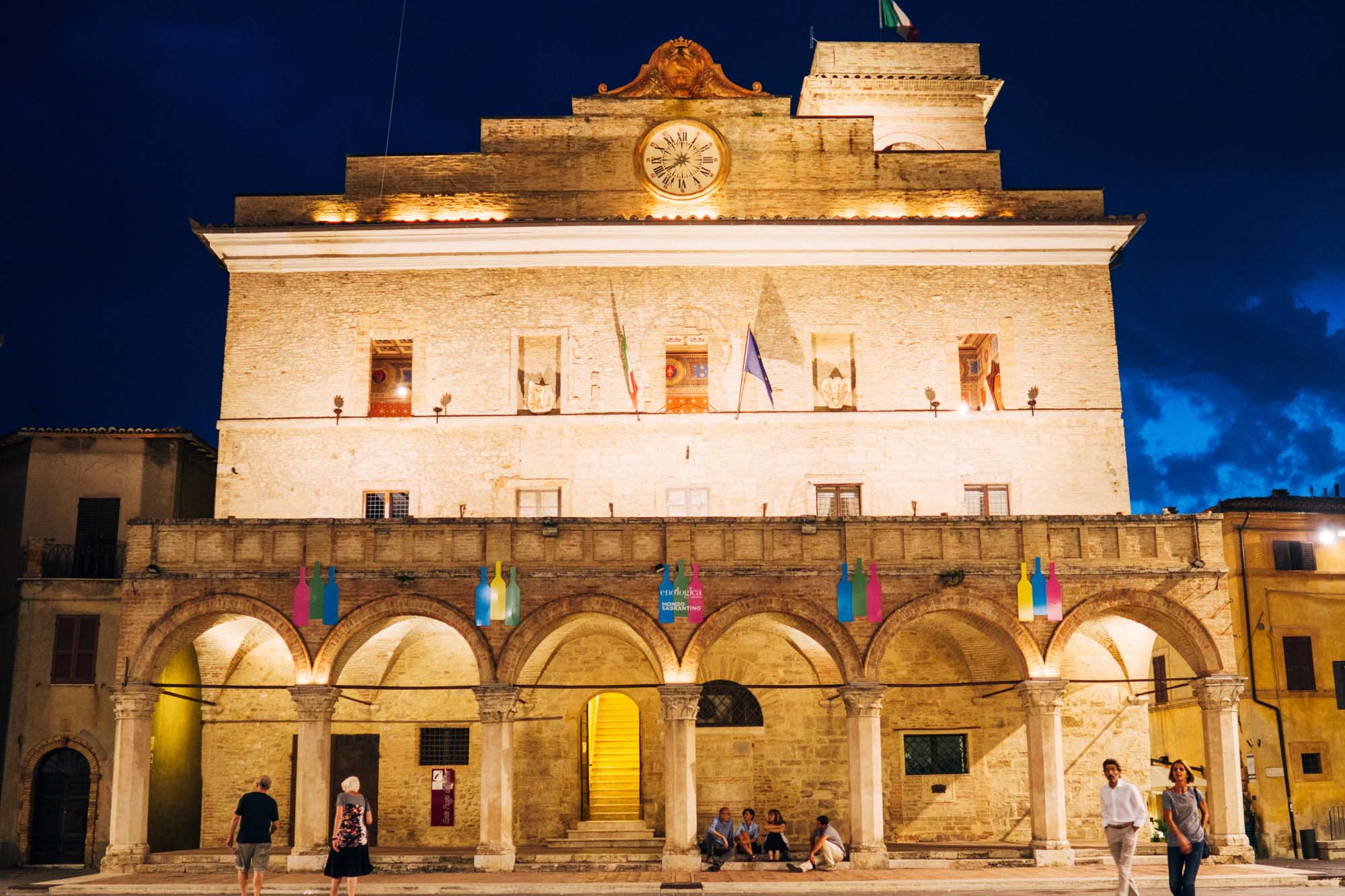
Montefalco bears this name, which replaced the ancient Coccorone o Concurionprecisely because Frederick II attributed it to the village around 1249-50, after his stay. Today, no more hawks, but the ancient charm of this place has probably remained intact over the centuries. The hill of Montefalco is the highest (473 m. a.s.l.) of a hill system on the edge of the Valle Umbra between Assisi and Spoleto and crossed by the Clitunno and Topino rivers. The Sources of the Clitumnolatent literary suggestions resurface and lead us back to a series of quotations from Pliny a Byron, from Carducci a Goethe. They are surrounded by willows and poplars, of undeniable charm, even though the river is no longer navigable as far as the Tiber as it once was. The town took on its rational structure in Roman times, and was the site of numerous aristocratic villas such as that of the patrician Marco Curione from whom, according to tradition, the ancient name of the place derives.
It was between the 11th and 14th centuries that Montefalco had its period of greatest splendour: artistic, economic and also spiritual due to the intense activity of the Benedictine, Augustinian and, of course, Franciscan orders, which had an important settlement here. In the 16th century, two scourges: the sacking by the Perugian Baglioni family and a devastating plague epidemic led to the decline of the town, which today, thanks to its intact structure and an intelligent enhancement of its artisan, agricultural and gastronomic traditions, is an interesting stop for the most attentive tourist. The heart of Montefalco, gathered within 14th-century walls, is the town hall squareunusually circular, vast and sober, with the Town Hallbuilt around 1270, to which were later added the loggia (15th century) and the tower (19th century). A visit to Montefalco cannot be separated from the City Museum, housed in theformer church of St Francis (c. 1335); on the central apse are the twelve panels depicting the life of the Assisian saint, painted by Benozzo Gozzoli (1420-1497), the Florentine painter who, after collaborating for a long time with Fra Angelico, began an independent artistic career in Montefalco. His is also the fresco of the Chapel of St Jerome, while the Annunciation and the Cribin front are from the Perugino. The Lapidary Museum houses carved or engraved stones and marbles from a vast surrounding area, in the Municipal Art Galleryworks by Francesco Melanzio of Montefalco, a painter linked to the High School of Foligno and the Alunno. From the Camiano Gate (13th century) one can enjoy the view over the Spoleto valley, while near the Gate of Frederick IIor of St Bartholomew, there is the homonymous little church decorated with shoots and bunches of grapes. And again: the Gothic Church of St. Augustinewhich preserves theCoronation of the Virgin attributed to Ambrogio Lorenzetti; i convents of Santa Illuminata and San Leonardowith works by Francesco Melanziothe shrine of St Clare (built in the Baroque period over the Chapel of the Holy Cross, where Clare of Montefalco died) which houses 14th-century frescoes of the Umbrian school. Finally, a one-kilometre walk through the countryside leads to the convent complex of San Fortunato where many archaeological finds from Roman times are preserved.
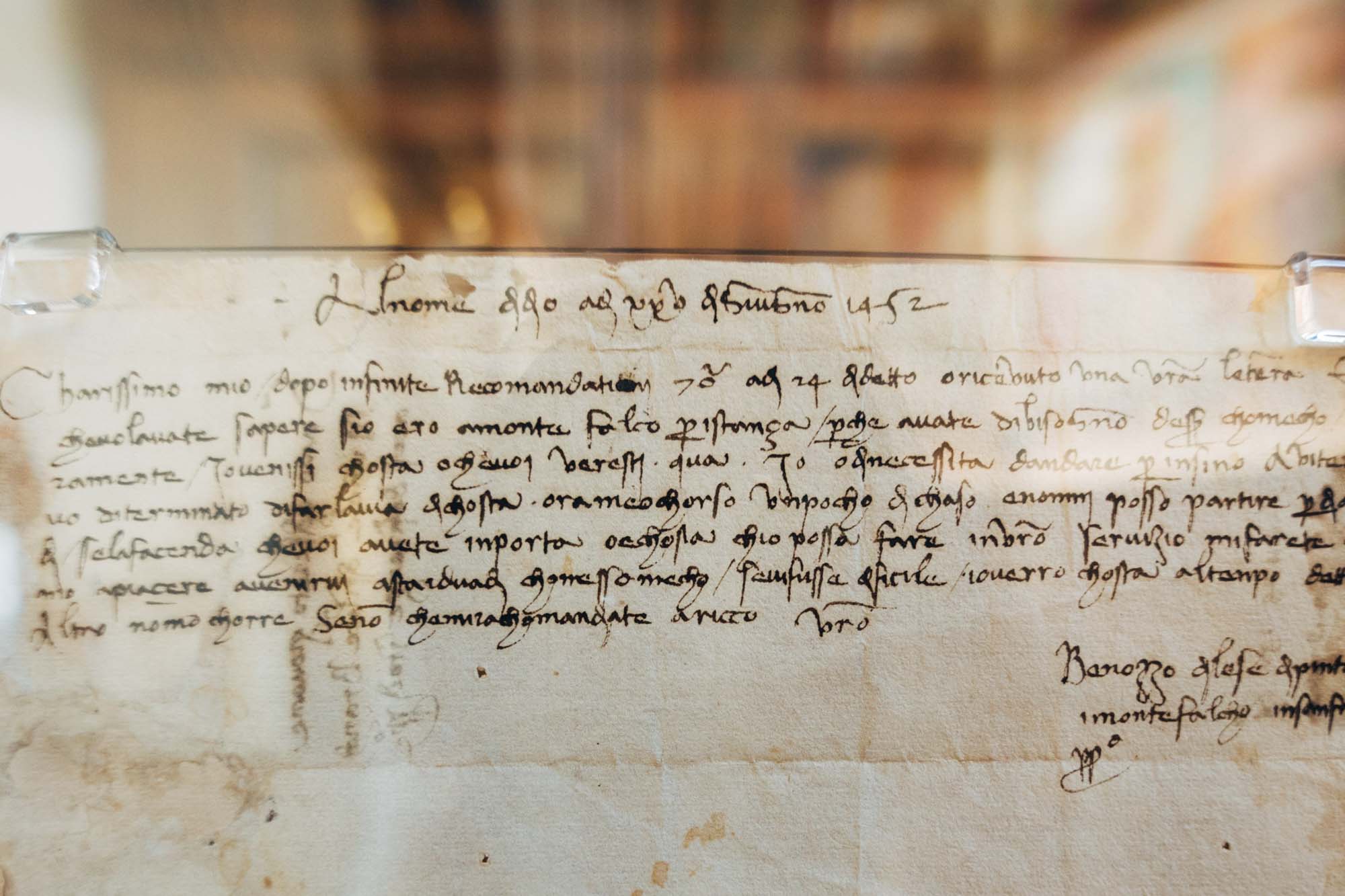
Up through the ancient gate a steep, narrow, dark street, and everywhere you look, wherever you pass, everything is ancient, medieval, stony cold and hard. Tiny alleys carved out between tall rough stone houses, ancient towers, portals, castles, churches and walls. At the top I was greeted by a cold, sharp wind. Bundled in my cloak, I had a beautiful and touching vision: beyond an ancient wall, the Umbrian landscape, green and bright, enclosed within a mighty circle of high, still snow-capped mountains. Near or far, there is no sight that does not touch an ancient, famous, sacred place; there it is Spoleto, Perugia, Assisi, Foligno, Spello, Terniand in between hundreds of smaller places, villages, churches, courtyards, monasteries, fortresses and farmhouses: a land rich in history, Roman and pre-Roman monuments, crossed by the small river Clitumno, which we often read about when we studied Latin... Dumbfounded with wonder, I crossed the square, exited the city through one of the gates, re-entered through the next, walked along corners and steep streets. Outside the city I found a magnificent garden surrounding a solitary villa, now uninhabited and somewhat dilapidated; there I rested under old cypress trees, watching the alternation of broad patches of shade and thin streaks of sunshine in the green valley. I saw Assisi and, nearby, the Porziuncolasacred places, transfigured by the grace and enchantment that St Francis and ancient Umbrian art have infused into this land. And then I set out to follow the traces of this Franciscan art beyond Assisi, no place offering better opportunities than Montefalco. Inside churches and chapels, above portals and altars, I discovered ancient frescoes populated with delicate figures pervaded by joyful devotion: beautiful merciful madonnas, graceful young saints. Sacred images taken from biblical history and hagiography, some mournful and severe, others aflame with devotion, others still laughing with childlike joy...
Where the history of Sagrantino has never suffered a setback In Montefalco, you can feel the deep breath of the past, which joins with that of the present. Between the walls of rosy ashlars, along the narrow alleys, stretching out to gain the great light of the Vallata, a few Sagrantino vines.
Tenacious, they remain to mark, in the continuity of gestures and traditions, the suture between eras. Still opulent at every harvest, they tell of an ancient presence of domestic vines surrounded by the high walls of vegetable gardens, testifying to the uninterrupted and constant love, the enduring predilection of Montefalco for this vine that is its symbol, its wealth, its pride. To follow its traces through the tangle of houses tightly clinging to the buttresses shrouded in haloes of shadow, is to enter an ideal territory and find there, in the rare symbiosis between vine and stone, the suggestion of human presence, as if restored to the everyday of Time. In the luminous wide of the 'Castellina' strong shrubs, living creatures, preserved by the careful will of man. In 'via de' Vasari' On the walls, as in a thirteenth-century sinopia, is written the continuous change of man's project, his sense of self, his aspirations. The houses are lined up almost in silent procession, alternating with shy vegetable gardens with walls of stone and limestone from which shadows of green escape, with "closed"from which the overbearing vegetation overflows onto the warm pink brickwork. Behind the small antique-painted porticos, scourged by the sun and the frost of mute seasons, one can guess the generous vineyards of yesteryear, the memory of which remains in short rows of vines. In this village, the union between the life of the fields and that of the craftsman was a happy one. The intimate nature of Montefalco is made up of humility, rigour, strength, tenacious ties with the land, which has always been its vocation. In front of an ancient well, from which the area has long quenched its thirst, clinging to the façade of nearby houses, more Sagrantino vines. Next to the oldest ones, spreading their centuries-old arms on the walls, young vines that have recently been renewed, carefully supported by painless supports: they suggest the reassuring idea of a youth ready to take the place of old age to guarantee the continuity of existence, that of a parallel path between man and land, capable of perpetuating that empathetic relationship that in the past man knew how to live with the environment, keeping it intact for posterity like a work of art.
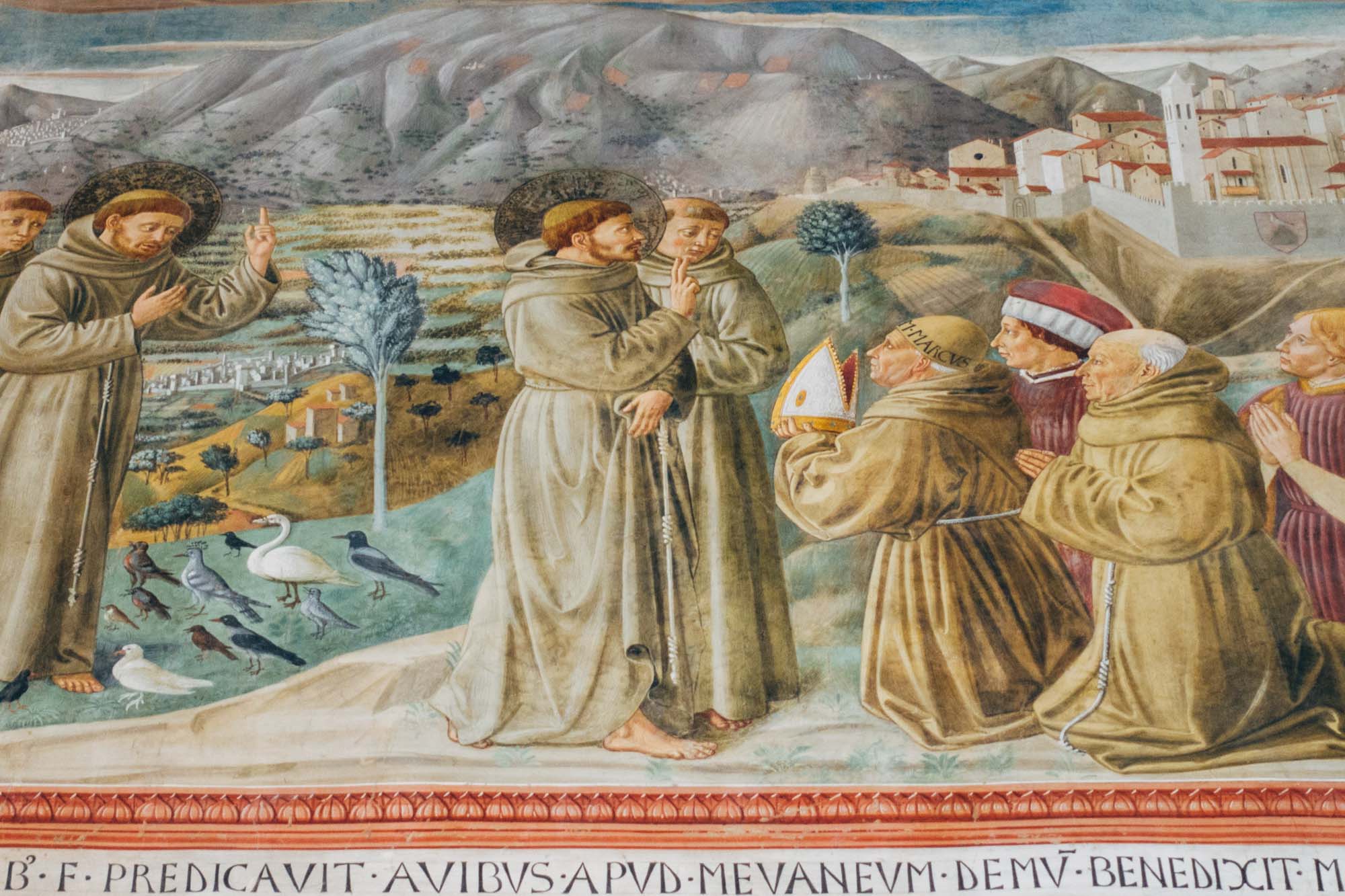
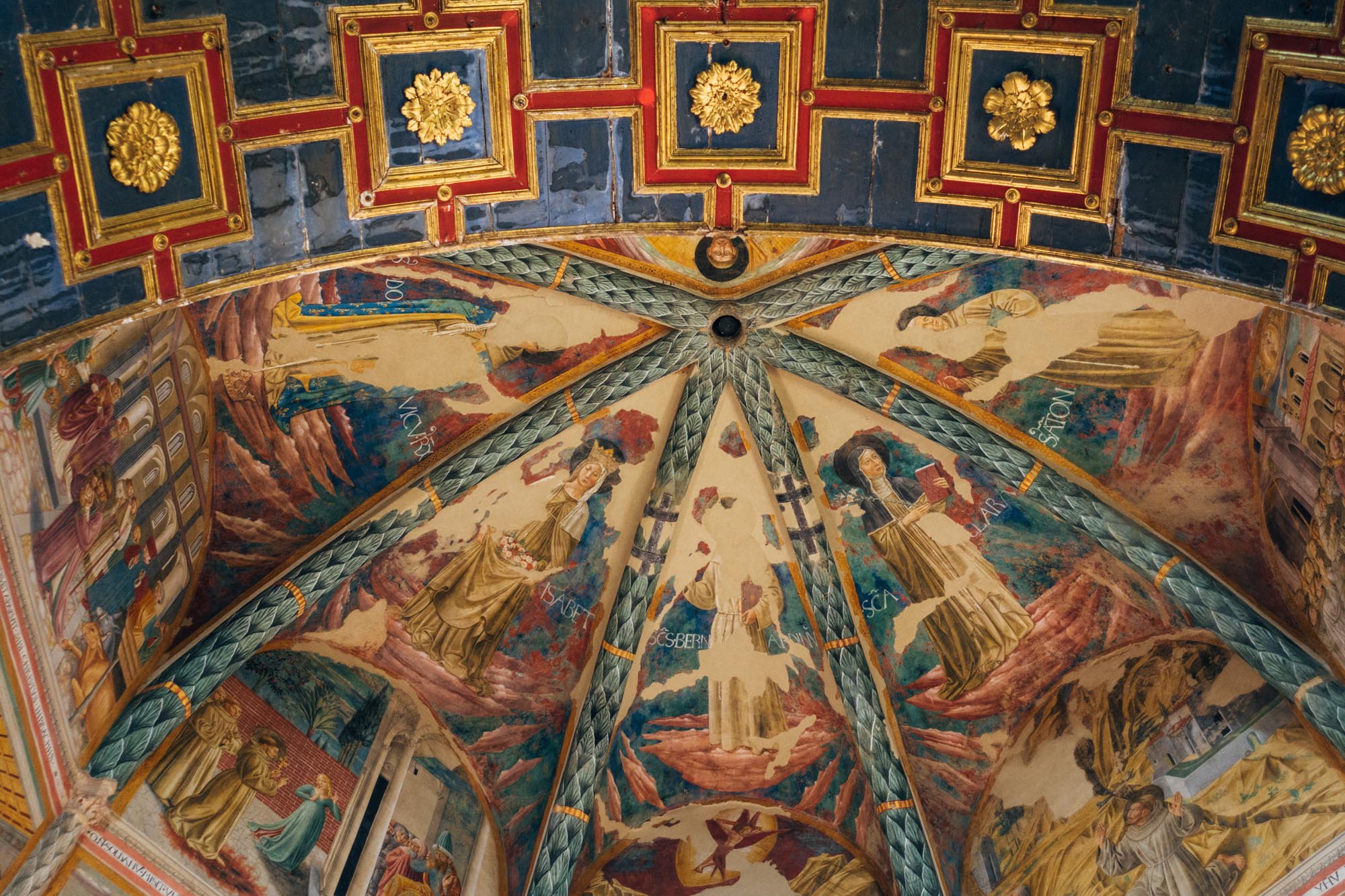
If not here, where? It is not a question, a doubt: it is the recherche that will accompany even the most lay traveller through a geography of the spirit traced by genius, substantiated by the sacredness of creation. If not here, where could Brother Francis have written his gospel of naturalness? It is a levity of soul that you will be left with from your encounter with places where rurality becomes elegance, the landscape amazement, art wonder and medieval architecture is transformed from grim buildings into delicate caskets of human events.
It will not be by chance that your madeleine will be a goblet of wine because recherche here is not poignant introspection, but a sunny reading of the relationship between man and the earth. The here is Montefalco. They call it the 'railing of Umbria'. Feel the peculiarity of the word: railing. It evokes domestic and popular atmospheres, has a lively rhythm and an inclusive meaning. Because Montefalco attracts: it allows the gaze alone the freedom to run over the hilly horizon. The bliss of the eyes is the theme of a score that harmonises eternal art and secular becoming, counterpointed by the pleasures of the glass and the table. The eyes that Benozzo di Lese di Sandro fills with light, with severity, with spirit. Those of St Francis planted in those of St Dominic, those of Christ who makes himself a pilgrim, those of the simple man who implores the Spirit. Our eyes captured by the fresco of the church of St Francis, a unique pictorial event. This is the reason for our journey through the Umbrian Renaissance "written" by Benozzo to whom Vasari gave the surname of Gozzoli. Montefalco, which of the great Florentine, "painter" and pupil of Beato Angelico, is with Orvieto and San Gimignano the place of choice, dedicates an exhibition to him that is a memorable event. Hardly ever has such a dense review of painting between the 14th and 16th centuries been proposed in the places where it was produced. So much so that the frescoes of the life of St. Francis, narrated in the church of the same name that is also home to Montefalco's picture gallery, become a paradigm of the surrounding landscape. Starting with that cruet of wine that Benozzo paints on the Franciscan table. He tells us about Sagrantino. It is the wine that is the symbol of Montefalco, which is said to have been produced by the Franciscan monks to say mass, and of which ancient vines, declared a vegetable monument, still survive in the urban fabric. You will come across them as you wander up the cart tracks, skirting the ancient Spedale, reaching the piazza and climbing to the top of the tower of the Municipio (Town Hall) from which the masterpiece Umbria is announced. Seen from there, it really does look like a fresco of the good Lord. Let us therefore read it, as we will do with Benozzo's work. To the north one glimpses Perugiajust below Foligno who contended in arms with the 'capital' several times over the legation of Montefalco. Foligno deserves the meeting because it preserves intact not only the urban structures but also the customs of the mediaeval fabric. Assisi is beyond. The Franciscan cradle appears geographically remote from here, but very present is the culture of the 'poverello', which Gozzoli nonetheless imbues with aristocratic asceticism. Just as aristocratic appears, looking eastwards, Spello. It is coiled on its hill, with a stony elegance. In Spello you will find another great Pinturicchio in the church of Santa Maria Maggiore. And don't forget the climb to the Mount Subasiosuggestive ascent through woods and olive groves. Closer to Montefalco is Bevagna designed by the Clitunno (the entrance to the city walls from the ancient wash-houses is poignant), which has a jewel-like theatre and an atmosphere of ancient nobility narrated by the splendid Roman mosaics. And then Trevi. Here the civilisation of oil is supremely recounted, here Pinturicchio and Giovanni di Corraduccio left admirable traces of their art, here from Sant'Emilia you will enjoy the incomparable view of the Clitunno valley that romantically waits to bewitch you at its springs and with the small Roman temple that celebrates the god of water. It is a place you will imagine populated by Nymphs and Elves. That pagan imagery does not contrast with Franciscan sacredness, as the harmony of the places builds an Arcadia of the beautiful and the natural. Looking towards Spoleto (the city alone is worth a visit) here Rittaldi Castlewhere the sacred art of Tiberius of Assisi is condensed in the beautiful parish church of San Nicola. And again to tell us of the richness of the landscape and widespread art here is Giano dell'Umbria which offers a view of the Church of San Michele, another treasure trove of art. Just beyond is Gualdo Catteneo of which the cylindrical tower is admirable and where, in Sant'Agostino, we find a remarkable fresco by the Alunno workshop, the protagonist of the entire 15th-century Umbrian school of painting. An art that tells through images of this millenary rural civilisation, still legible today in the vineyards, olive groves and flavours of Umbria. Of these panoramas, the genius loci resides in the cycle of San Francesco in Montefalco. Benozzo, almost as if he had rewritten with figuration the verses of the Canticle, narrated in those "paintings" not only the spiritual vicissitude, the biography of the Saint, but his lands. Even today Brother Sun makes them splendid with life, Sister Moon shadows them with spirit. It is the gospel of Brother Francis. That of nature. And if not here, where?
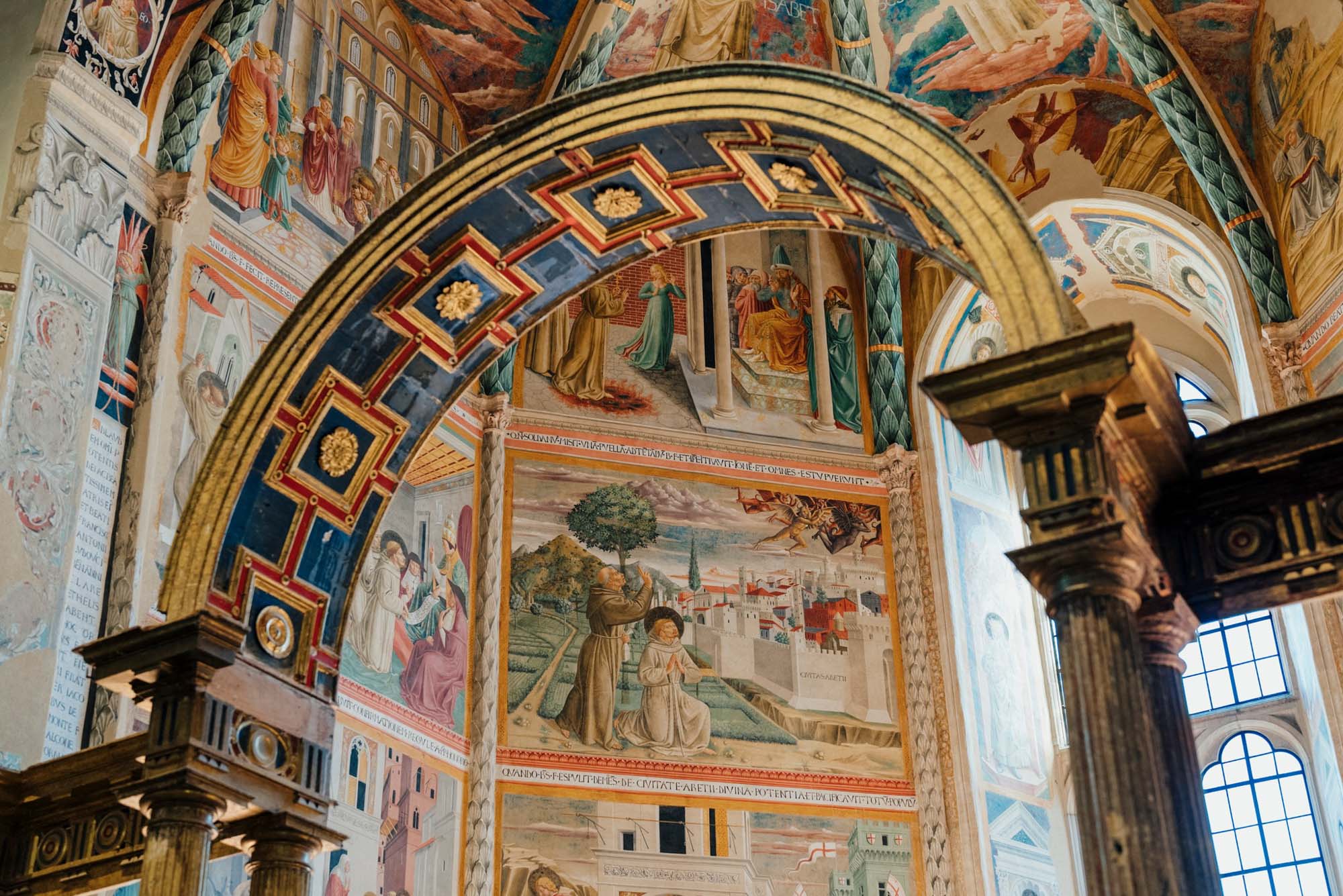
The St. Francis Municipal Museum in Montefalco preserves the fresco cycle of Benozzo Gozzoli with stories from the life of St. Francis: a significant work not only for its undisputed artistic value but also because it is fundamental to understanding the iconographic reference of Sagrantino di Montefalco. The museum of St. Francis represents a laboratory experience for the museum system. Between 1983 and 1990 it was restored by the Region, proceeding in small batches, and then reopened, entrusting its management to Museum System. It is a cooperative established in 1990 and based in Perugia. It works in various museums and circuits, providing qualified staff and organising a range of activities to enliven the museums. In Montefalco, maintenance of the works and premises is ensured and exhibitions, concerts and other cultural activities are organised. Educational activity with the school is intense. The bookshop of the museum is rich in publications. The resident population, as well as tourists, have benefited from the activity, in line with the regional spirit of returning cultural assets to the citizens. This is an example of how the municipality of Montefalco is in step with the times. Central apse of the former Church of St. Francis, now the Civic Museum of Montefalco Benozzo Gozzoli, Stories from the Life of Saint Francis, Saints and Characters of the Franciscan Order, frescoes, 1452. State of preservation and restoration. Benozzo's cycle has faced a long and adventurous history of neglect, misunderstandings, and damage, which have seriously endangered the survival of this pictorial text, one of the most important in early Renaissance Italian painting. The 1997 earthquake accentuated the state of instability of the vault, causing the partial detachment of a rib, but did not damage the frescoes. In general, the original parts of the cycle are largely preserved.
Commissioning. The work was commissioned by Fra Jacopo da Montefalco, guardian of the Convent of St. Francis, who is mentioned in the dedicatory inscription and portrayed in the episode of the Blessing of the People of Montefalco. However, it was Friar Antonio da Montefalco, of the 'rival' Order of the Observants, who first called Benozzo to the Umbrian city. Antonio got to know the artist when he was working as Beato Angelico's assistant on the decorations in the Vatican. Appreciating his talents, he secured his presence in Montefalco in 1450, commissioning the artist to create both panel and fresco works for his church of San Fortunato. These works must evidently have met with Fra Jacopo's taste, if two years later Benozzo was called to work on the convent church of San Francesco. Benozzo moved unhurriedly from one church to another. The results that the painter achieved were profoundly different, as the message that the two patrons suggested to him was different. Sources. Called upon to illustrate the life of St. Francis, Benozzo used the great Giottesque model, but departed from it, as, at the probable suggestion of Friar Jacopo himself, he referred to two well-known Franciscan texts: the Legenda Maior by Bonaventure of Bagnoregio, which became the official biography of the saint from 1266, and the Legend of the Three Companions, which, focusing above all on the events in Assisi of Francis, was often an important source of inspiration for the depiction of the related scenes. The cycle. The life of the saint, from birth to death, is illustrated in twelve scenes arranged in three registers. The narrative proceeds, like an ideal elevation, from bottom to top and culminates in the vault with the glory of Saint Francis. The leitmotif of the cycle is the identification of Francis as the 'new Christ' (alter Christus), a central concept of Franciscan spirituality. The second register shows in a panel the scene of a dinner, whose protagonists are St. Francis and the Knight of Celano, by whom the saint had been invited. Two bottles are depicted on the table, one of water and one of red wine, and since there are frequent references to contemporary events and local characters, as in the scene of the Blessing of Montefalco and its people, the detail of the red wine could also be interpreted as a precise reference to the production of Sagrantino di Montefalco, a wine whose name derives precisely from its use in the imparting of the sacraments. Style. Benozzo found himself directing a painting site for the first time after having been employed by Angelico for many years in Florence, Rome and Orvieto. The great master's lesson is fundamental for the organisation of the cycle. In the adoption of particular compositional modules, in the predilection for certain human types and in the balance of colour, the memory of the years in which he was closest to Angelico guides Benozzo in this undertaking. However, as had been the case in his early Montefalco works in San Fortunato, the barely thirty-year-old Benozzo reveals absolutely original qualities in the Franciscan cycle: a more particularistic taste for narrative, a use of colour in a function that is both expressive and decorative. Criticism. Benozzo's Umbrian activity, completely forgotten by Vasari, was particularly appreciated during the 19th century, when a mystical interpretation was attempted. Benozzo's Franciscan Stories in Montefalco were of significant importance for the transformation of figurative culture in Umbria in the Proto-Renaissance sense.
